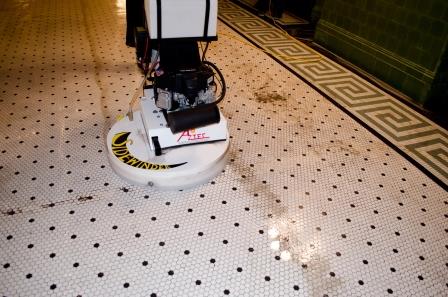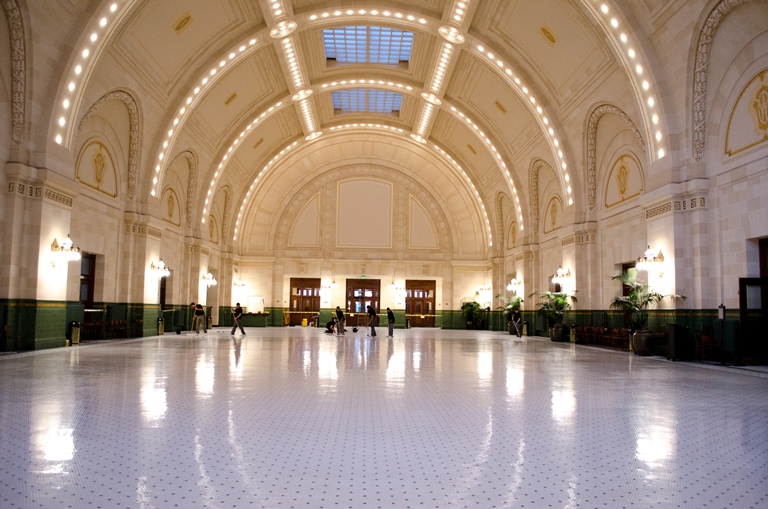Picture a bustling train station in the Pacific Northwest in the early 1900s — a place filled with people off to explore new opportunities. Now, picture the floor of that same train station more than a century later. That was the situation faced by Clear Conscience Sealants when they arrived on the scene at this historic train station in Seattle. It was going to take quite a bit of prep work — and a great coating system — to get the floors back to the way they looked at the turn of the 19th century.
“We were contracted to restore the 100-year-old tile and grout in the 13,000-square-foot [1,208 m²] great hall, or lobby area, of Union Station, and get it back to looking as it did when the train station was first built,” explained Mike Sherstad, president of Clear Conscience Sealants. Union Station is no longer an active train depot, but it houses commercial and office space. It is also a designated Historic Building maintained by Sound Transit, the regional Puget Sound transit authority.
According to Sherstad, working on a historic building means exercising a great deal of caution. “In a historic building like this, we didn’t know if there were any leaks in the floor that could cause water damage to the building. We needed to use as little water as possible and be very careful when we did use it,” stated Sherstad. Also, the team needed to be exceedingly careful not to damage any existing walls or fixtures in the facility, as nothing could be replaced. “If any damage occurred, it would need to be repaired by an expert and could prove very costly,” said Sherstad.
Keeping the job as green as possible was another factor to consider. Seattle is an environmentally conscious city and the procedures, processes, and materials used on this job needed to adhere to the city’s standards. In addition, the work was to take place after hours, as the building was to remain open during the floor restoration. Sound Transit wanted a low volatile organic compound (VOC) coating material so that building occupants would not be affected by odors when they came to work in the morning. For this particular project, the Clear Conscience team coated the tile and grout with Ultra Durable Technologies’ EPIC Tile and Grout urethane system.
Dirty Job
 When the 8-person crew arrived on the scene, they were surprised to see that the condition of the tile and grout was actually pretty decent for a 100-year-old floor. They were, though, a bit shocked at the actual color of the grout after cleaning it. “The grout lines were so filled with dirty wax that they were black in appearance. The underlying grout was actually light gray after we stripped all the wax and cleaned the floor,” revealed Sherstad.
When the 8-person crew arrived on the scene, they were surprised to see that the condition of the tile and grout was actually pretty decent for a 100-year-old floor. They were, though, a bit shocked at the actual color of the grout after cleaning it. “The grout lines were so filled with dirty wax that they were black in appearance. The underlying grout was actually light gray after we stripped all the wax and cleaned the floor,” revealed Sherstad.
To speed up the wax stripping process, Clear Conscience subbed out the work to Seattle Building Maintenance, who used high-speed stripping machines to get all of the built-up wax off the floor. According to Sherstad, the wax stripping machines are zero emission, propane-powered floor strippers called “Sidewinder” by Aztec.
Once stripped, the tile and grout were deep cleaned. “The synthetic acid wash was performed using Blue Green Systems’ ‘3-in-1’ cleaner. This is an acid-like product, but non-corrosive,” explained Sherstad.
Grout It Out
 After all the wax had been removed and the entire floor area was cleaned, the crew applied Polyblend grout colorant in antique white to the entire surface of the great hall. Once dried, the grout colorant was removed from the tile and left in place in the grout lines. The crew used a 175 rpm floor polisher to remove all the excess grout. “We used black stripping pads and water with the floor polisher; no chemicals were used to remove the grout,” said Sherstad.
After all the wax had been removed and the entire floor area was cleaned, the crew applied Polyblend grout colorant in antique white to the entire surface of the great hall. Once dried, the grout colorant was removed from the tile and left in place in the grout lines. The crew used a 175 rpm floor polisher to remove all the excess grout. “We used black stripping pads and water with the floor polisher; no chemicals were used to remove the grout,” said Sherstad.
With the excess grout removed, it was then time for the team to repair any of the decorative black tiles that may have been chipped over time. Because the century-old tiles could not be replaced, the Clear Conscience team painstakingly hand-painted the chipped tile with black paint and a small artist brush. According to Sherstad, this process alone took about 40 man hours!
Good as New
After nearly three weeks of prep work, it was finally time for the coating work to begin. “The prep work was by far the longest and most tedious part of the job. We finished the coating work in just a few hours, since we were able to coat approximately 5,000-square-feet [465 m²] per hour with the EPIC water-based urethane,” stated Sherstad.
The EPIC urethane was t-barred on and then back-rolled to provide a thin, durable coat. According to Sherstad, the t-bar process goes much more quickly than if they had used rollers to apply the urethane coating. The EPIC was laid down at about 1–1.5 mils [25–38 microns] dry film thickness over the tile and a bit thicker over the more porous grout lines. Only one coat of EPIC was required to get the job done. As the material is low VOC, the crew had very few safety concerns, but they did use gloves when mixing the material.
According to Travis Negaard of Ultra Durable Technologies, the original EPIC formula was designed to be applied to hospital floors. “Most hospitals desire a high gloss finish because of the perception that ‘shiny equals clean;’ however, it can be very difficult to keep floors shiny in these high-traffic environments that basically never shut down. EPIC was created to meet the high demands of the healthcare environment,” said Negaard.
The EPIC Tile and Grout system was designed to be a complete membrane that covers each individual tile as well as the grout. Once cleaned and coated, the grout becomes easy to clean and is no longer a breeding ground for bacteria. Applications of EPIC have now expanded to schools, commercial buildings, and even retail establishments.
Sherstad and Sound Transit are thrilled with how the product is performing. “The gloss is amazing and really highlights the architecture in this historic building,” stated Sherstad. For a century-old floor, it’s a modern-day upgrade!
